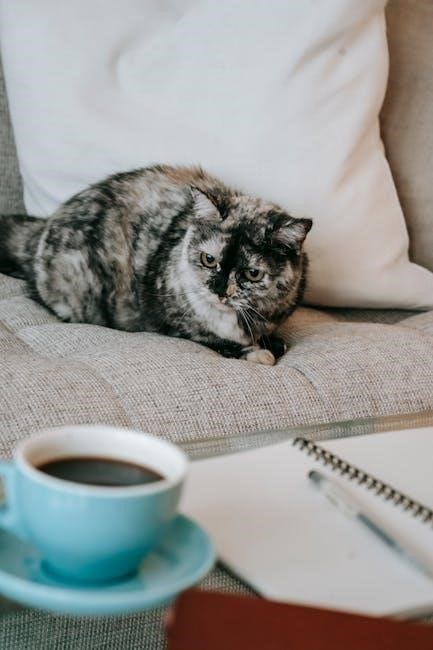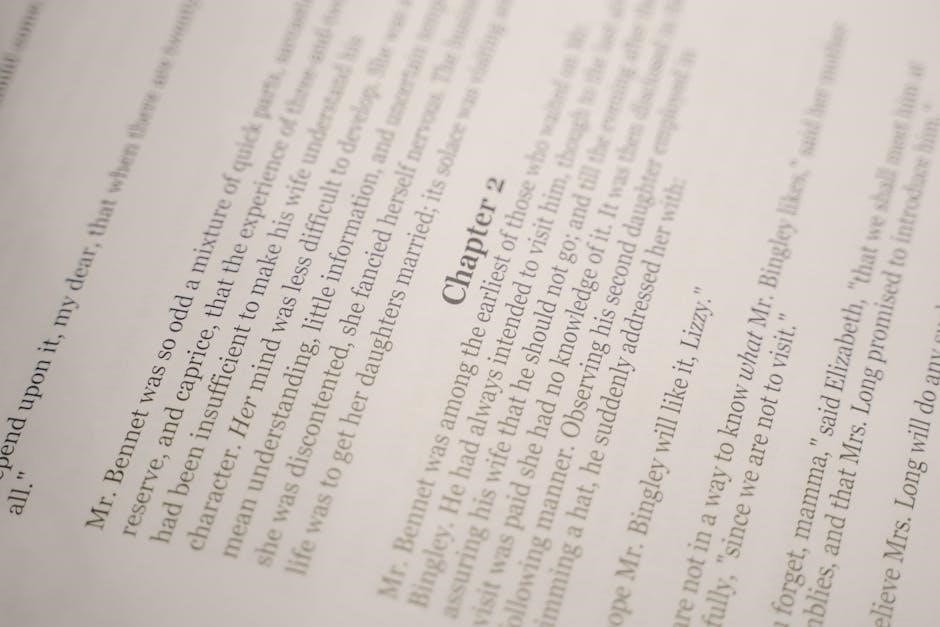Discover how Jessica Brody adapts Blake Snyder’s iconic screenwriting method into a novel-writing guide, offering a clear roadmap for crafting compelling stories with 15 essential plot beats.
Overview of the Save the Cat! Method
The Save the Cat! method, originally designed for screenwriting by Blake Snyder, has been adapted for novelists by Jessica Brody. It focuses on 15 essential plot points that ensure a story’s structure is engaging and effective. These beats provide a roadmap for writers, helping them create a compelling narrative with a clear beginning, middle, and end. The method emphasizes character development, pacing, and emotional resonance, making it a versatile tool for writers across all genres; By following these beats, novelists can craft stories that captivate readers and leave a lasting impact.
Relevance of the Save the Cat! Method for Novel Writing
The Save the Cat! method is highly relevant for novel writing as it provides a structured approach to storytelling, ensuring a clear narrative arc. By breaking a story into 15 essential beats, writers can effectively pace their plot, develop characters, and create emotional resonance. This method is particularly useful for novelists as it helps maintain reader engagement, ensures logical progression, and enhances the overall impact of the story. Its adaptability across genres makes it a valuable tool for refining and strengthening any novel’s structure.

The 15-Beat Structure for Novels
The 15-Beat Structure, adapted from screenwriting, provides a clear framework for novelists to organize their narrative into key plot points, ensuring a compelling and structured story flow.
The 15 essential plot points, derived from Blake Snyder’s Save the Cat! method, provide a foundational structure for novels. These beats, such as the Opening Image, Theme Stated, and Catalyst, guide writers through key story milestones. Each beat serves a specific purpose, ensuring a balanced and engaging narrative. By following this framework, novelists can craft compelling stories with clear beginnings, middles, and ends. Jessica Brody’s adaptation tailors these beats for novel writing, offering practical examples and insights to help authors structure their work effectively and maintain reader interest throughout. This approach ensures a cohesive and impactful storytelling experience.
Breakdown of the ThreeActs
The Save the Cat! method divides a novel into three acts, each serving a distinct purpose in the story’s progression. Act 1 sets up the story, introducing characters, themes, and conflicts. Act 2 develops the narrative, presenting challenges and escalating tensions. Act 3 resolves the story, delivering a satisfying conclusion. Each act contains specific beats that guide the writer, ensuring a balanced and engaging structure. Jessica Brody’s guide provides detailed insights into how these acts work together to create a cohesive and compelling novel, with practical examples to illustrate each section.
Specific Beats in Each Act
Each act in the Save the Cat! method contains specific beats that guide the narrative. Act 1 includes the Opening Image, Theme Stated, Set-Up, Catalyst, Debate, and Break into Two, setting up the story and propelling the protagonist into action. Act 2 features the B Story, Fun and Games, Midpoint, Bad Guys Close In, All is Lost, and Dark Night of the Soul, where conflicts escalate and the protagonist faces their lowest point. Act 3 includes Break into Three, Finale, and Final Image, resolving the story and delivering a satisfying conclusion; These beats ensure a structured and engaging narrative flow.

Adapting the Save the Cat! Method for Novels
Jessica Brody adapts Blake Snyder’s screenwriting framework for novels, emphasizing the 15 essential beats to enhance storytelling, pacing, and character development in any genre.
Differences Between Screenwriting and Novel Writing
While the Save the Cat! method originated for screenwriting, its adaptation for novels highlights key differences. Screenplays focus on visual storytelling and concise dialogue, whereas novels emphasize internal thoughts, detailed descriptions, and character depth. Jessica Brody explains how novels require a slower pacing and more nuanced narrative style. The 15-beat structure remains consistent, but novels allow for richer character development and thematic exploration. Novels also offer more flexibility in non-linear storytelling, unlike the rigid linear structure of screenplays. These distinctions make the Save the Cat! method adaptable yet uniquely suited for novel writing.
How to Apply the 15 Beats to Novel Writing
Applying the 15 beats to novel writing involves adapting the Save the Cat! structure to the unique demands of prose. Start by identifying each beat in your story, ensuring they align with key plot points. Use the beats to pace your narrative, balancing action, dialogue, and internal monologues. Unlike screenwriting, novels allow for deeper character introspection and descriptive detail. Jessica Brody provides examples and templates to help novelists implement these beats effectively, ensuring a compelling and well-structured story while maintaining creative freedom and emotional depth.
Examples of Successful Novels Using the Save the Cat! Structure
Novels like The Hotel Nantucket and Big Summer exemplify the Save the Cat! structure in action. These stories hit the 15 essential beats, from the Opening Image to the Final Image, demonstrating how the method ensures a compelling narrative. Jessica Brody provides detailed analyses of these examples, showing how each beat aligns with key plot points. These case studies offer writers practical insights into adapting the structure for their own genres, proving its versatility and effectiveness in crafting engaging stories across different styles and audiences.
Jessica Brody and Her Approach to Novel Writing
Jessica Brody, a bestselling author and writing coach, offers a comprehensive yet accessible approach to novel writing by adapting the Save the Cat! method for novelists.
Biography of Jessica Brody
Jessica Brody is a bestselling novelist and writing coach, known for adapting Blake Snyder’s Save the Cat! screenwriting method into a novel-writing guide. Her work bridges the gap between screenwriting and novel writing, providing novelists with practical tools to structure compelling stories. With a deep understanding of storytelling principles, Brody has helped countless writers improve their craft through her books and workshops. Her approach emphasizes clear plot points and genre-specific insights, making her a respected figure in the writing community.
Her Role in Adapting the Save the Cat! Method
Jessica Brody played a pivotal role in translating Blake Snyder’s Save the Cat! screenwriting method into a novel-writing framework. She tailored the iconic 15-beat structure for novelists, providing genre-specific insights and practical examples. Brody’s adaptation ensures the method’s core storytelling principles remain intact while addressing the unique demands of novel writing. Her work has made the Save the Cat! approach accessible to authors across genres, offering a clear roadmap for crafting structured, engaging stories. This adaptation has become a cornerstone for many novelists seeking to enhance their storytelling skills.
Key Insights from Her Work
Jessica Brody’s adaptation of the Save the Cat! method offers novelists a structured approach to storytelling, emphasizing the importance of 15 essential plot beats. Her work provides practical tools, such as beat sheets and genre-specific examples, to help writers craft compelling narratives. By focusing on universal story principles, Brody ensures that her method is versatile, applicable to any genre. Her insights empower writers to create stories with clear structure, emotional resonance, and engaging character arcs, making her approach invaluable for both aspiring and experienced novelists seeking to enhance their craft.

The Book “Save the Cat! Writes a Novel”
Jessica Brody’s guide adapts Blake Snyder’s screenwriting method, revealing 15 essential plot points for novel success, offering a comprehensive roadmap for writers to craft compelling stories.
Overview of the Book’s Content
Save the Cat! Writes a Novel by Jessica Brody is a comprehensive guide that adapts Blake Snyder’s renowned screenwriting method for novelists. The book introduces the 15 essential plot points, or beats, that are crucial for structuring a successful story. It covers the entire storytelling process, from outlining to revising, and provides practical examples across various genres. Brody explains how each beat functions in a novel, offering tips and templates to help writers create engaging narratives. This approach ensures that writers can craft stories that resonate with readers, regardless of genre or style;
Key Concepts and Takeaways
Save the Cat! Writes a Novel introduces the 15 essential plot beats, a framework adaptable to any genre. It emphasizes the importance of a clear three-act structure and provides practical tools like downloadable templates. The book offers insights into genre-specific storytelling and examples from successful novels. Key takeaways include the flexibility of the method for novels, the importance of character arcs, and how to apply screenwriting principles to prose. This guide empowers writers to craft engaging, well-structured stories that resonate with readers across all genres and styles.
How the Book Helps Writers
Save the Cat! Writes a Novel provides writers with a practical, step-by-step guide to structuring their stories. It offers downloadable templates, genre-specific advice, and real-world examples to help writers craft compelling narratives. The book assists in outlining, revising, and troubleshooting common writing challenges. By breaking down the 15 essential plot beats, it empowers writers to create engaging stories with clear pacing and character development. This resource is invaluable for both new and experienced writers seeking to enhance their storytelling skills and produce polished, marketable novels.

The 10 Universal Story Genres
Jessica Brody introduces the 10 universal story genres, each fitting into the 15-beat structure with examples, helping writers craft compelling stories across genres to enhance storytelling.
Jessica Brody’s guide introduces 10 universal story genres, each with unique traits and audience expectations. These genres—ranging from Romantic Comedy to Monster in the House—are explored through practical examples, helping writers identify their story’s genre and align it with the 15-beat structure. By understanding these genres, novelists can craft narratives that resonate with readers, ensuring their stories meet audience expectations while maintaining originality and creativity. This approach simplifies genre identification, empowering writers to focus on storytelling excellence.
How Each Genre Fits into the 15-Beat Structure
Each of the 10 universal genres aligns seamlessly with the 15-beat structure, ensuring a cohesive storytelling framework. While genres like Romantic Comedy or Monster in the House have unique traits, they all adhere to the same foundational beats, providing a clear narrative path. This integration allows writers to maintain genre-specific elements while ensuring their story follows a proven, audience-pleasing structure. By understanding how each genre fits into the 15 beats, novelists can craft compelling, genre-specific stories that resonate with readers and deliver emotional satisfaction.
Examples of Each Genre in Novels
Each of the 10 universal genres is illustrated with examples from successful novels. For instance, Romantic Comedy is exemplified by The Hating Game, while Monster in the House is seen in The Girl on the Train. Big Summer by Jennifer Weiner perfectly aligns with the Save the Cat! beats, as does The Hotel Nantucket, showcasing how the 15-beat structure adapts to diverse genres while maintaining narrative coherence and emotional resonance.

Practical Applications of the Save the Cat! Method
The method offers practical tools like beat sheets and genre-specific examples, helping writers structure novels effectively and apply the 15-beat framework to their storytelling process;
Outlining Your Novel with the 15 Beats
Using the 15-beat structure, writers can create a clear roadmap for their novel, ensuring each plot point serves a purpose. From the opening image to the final resolution, this method helps break down the story into manageable sections. By focusing on key moments like the opening, theme stated, and break into two, authors can build a strong foundation. The beat sheet provides a visual guide, making it easier to organize ideas and maintain pacing. This approach simplifies the writing process, ensuring a compelling and structured narrative that engages readers from start to finish.
Revising Your Novel Using the Save the Cat! Framework
Revising your novel with the Save the Cat! framework involves analyzing each of the 15 beats to ensure they effectively serve the story. This method helps identify gaps, strengthen character arcs, and tighten pacing. By evaluating each beat, writers can refine plot points, enhance emotional resonance, and ensure a cohesive narrative flow. The framework also aids in balancing act structure and verifying that key moments align with the story’s purpose. This structured approach streamlines the revision process, making it easier to transform a draft into a polished, engaging novel.
Troubleshooting Common Writing Issues
The Save the Cat! method offers practical solutions for common writing challenges. Identify plot gaps by analyzing the 15 beats, ensuring each serves the story. Strengthen character arcs and pacing by refining these points. Address issues like sagging middles or unclear themes by revisiting key beats. The framework helps integrate subplots seamlessly and enhances emotional resonance. Use it to diagnose and fix problems, ensuring a cohesive narrative flow and a compelling story structure tailored to your novel’s needs.

Case Studies and Examples
Jessica Brody analyzes novels like The Hotel Nantucket and Big Summer, demonstrating how they hit the 15 beats, providing concrete examples of the method’s effectiveness in storytelling.
Analyzing Popular Novels Using the 15 Beats
Jessica Brody’s guide deconstructs bestsellers like The Hotel Nantucket and Big Summer, illustrating how each aligns with the 15 beats. She breaks down key plot points, showing how these novels effectively hit each beat, from the opening image to the final resolution. This analysis provides writers with practical insights, demonstrating how to integrate the Save the Cat! structure into their own work for a polished, engaging narrative. Brody’s examples highlight the versatility of the method across genres, proving its universal appeal.
How “The Hotel Nantucket” Hits the 15 Story Beats
The Hotel Nantucket seamlessly aligns with the Save the Cat! 15-beat structure. From the opening image of the island’s charm to the final resolution, each beat is executed with precision. The story stakes are clear, and the protagonist’s journey follows a compelling arc. The novel’s use of the “all is lost” moment and the subsequent climax showcases how the structure enhances storytelling. This analysis highlights how the Save the Cat! method can be effectively applied to create engaging, well-structured novels across genres.
Other Novels That Successfully Use the Save the Cat! Structure
Beyond The Hotel Nantucket, numerous novels have thrived using the Save the Cat! framework. For instance, Big Summer by Jennifer Weiner and The Hating Game by Sally Thorne also align with the 15 beats. These stories showcase how the structure adapts seamlessly across genres, ensuring compelling character arcs and pacing. The method’s universality allows authors to craft narratives that resonate deeply with readers, proving its effectiveness beyond screenwriting. These examples highlight the versatility of the Save the Cat! approach in driving successful, engaging novels.

Templates and Resources
Downloadable beat sheets, genre guides, and novel-writing templates are available, providing practical tools to apply the Save the Cat! method effectively to your storytelling process.
Downloadable Beat Sheets for Novelists
Novelists can access downloadable beat sheets tailored to the Save the Cat! method, providing a structured framework for outlining and revising their work. These templates, often included in Jessica Brody’s resources, offer a clear roadmap for implementing the 15 essential plot points. Examples from popular novels, such as The Hotel Nantucket, demonstrate how these beats work in practice. Additional resources like genre-specific guides further enhance the utility of these tools, making them indispensable for writers aiming to craft well-structured, engaging stories.
Additional Resources from Jessica Brody
Jessica Brody provides a wealth of additional resources to complement her book, including workshops, webinars, and downloadable guides. Her website offers tools like the Save the Cat! Genre Guide, which helps writers understand story types. She also shares tips on her blog and social media, offering insights into structuring novels effectively. These resources are designed to help writers master the 15 beats and apply them to their own projects, ensuring a solid foundation for crafting compelling stories across any genre.
Online Communities and Forums for Save the Cat! Enthusiasts
Jessica Brody’s blog and social media platforms offer vibrant communities for writers. Join Facebook Groups like Save the Cat! Writers or Reddit forums dedicated to novel writing. The Blake Snyder website hosts discussions and resources for enthusiasts. Additionally, writing communities like NaNoWriMo and Goodreads feature threads on the Save the Cat! method. These platforms provide spaces to share ideas, ask questions, and learn from fellow writers, fostering a supportive environment for mastering the 15 beats.

Benefits and Limitations of the Save the Cat! Method
The method offers a structured approach and proven framework, enhancing storytelling clarity. However, its rigidity may limit creative freedom for writers seeking more flexible narrative styles.
Advantages of Using the 15-Beat Structure
The 15-beat structure provides clarity and a proven roadmap for storytelling, ensuring a balanced narrative with well-timed plot points. It enhances pacing, keeping readers engaged, and guarantees character growth. The framework is adaptable to any genre, offering flexibility while maintaining a cohesive story flow. By following these beats, writers can avoid storytelling pitfalls, ensuring a satisfying beginning, middle, and end. This method also fosters creativity within a structured format, making it accessible for both new and experienced writers to craft compelling, professional-grade novels.
Potential Drawbacks and Criticisms
Some critics argue the 15-beat structure can feel rigid, potentially stifling creativity or leading to predictable narratives. While it offers clarity, it may not suit experimental or non-linear storytelling. The formulaic approach can sometimes result in stories feeling overly structured or lacking unique elements. Additionally, relying too heavily on the beats might limit a writer’s ability to explore unconventional themes or character arcs. However, many find the framework adaptable, balancing structure with creative freedom, making it a valuable tool for crafting engaging stories.
When to Use the Save the Cat! Method
The Save the Cat! method is ideal for writers seeking a clear, structured approach to storytelling. It’s particularly useful for novelists who struggle with outlining or need a roadmap to ensure their story hits key emotional and plot milestones. The method is also beneficial for revising drafts, identifying pacing issues, or strengthening character arcs. Whether you’re a debut author or an experienced writer, this framework provides a versatile tool to enhance clarity and engagement in your narrative, making it suitable for various genres and writing styles.

Testimonials and Reviews
Authors praise Save the Cat! Writes a Novel for its clear, actionable advice, calling it a “life-changing” tool that transforms writing and storytelling effectiveness.
What Other Authors Say About the Save the Cat! Method
Authors widely acclaim the Save the Cat! method for its clarity and effectiveness. Many praise Jessica Brody’s adaptation, calling it a “game-changer” for novel writing. Writers highlight how the 15-beat structure provides a clear roadmap, helping to organize stories and enhance pacing. The method’s universal appeal lies in its ability to apply to any genre, making it a versatile tool for both new and experienced writers. Several bestselling authors have credited the method with improving their storytelling skills and boosting creativity.
Reader Reviews of “Save the Cat! Writes a Novel”
Readers praise Save the Cat! Writes a Novel for its clarity and practicality. Many highlight its ability to simplify complex storytelling concepts, making it accessible for writers of all levels. The book’s focus on the 15-beat structure and genre-specific insights resonates particularly well. Reviewers often describe it as a “must-have” resource, emphasizing its value in outlining and revising novels. The inclusion of real-world examples and templates further enhances its appeal, helping writers apply the method effectively to their own projects.
Success Stories from Writers Who Used the Method
Many writers credit the Save the Cat! method with transforming their storytelling. One novelist reported landing a book deal after restructuring their manuscript using the 15 beats. Another writer praised the method for helping them overcome writer’s block and create a cohesive narrative. The clear structure and genre-specific insights have empowered authors to craft compelling stories that resonate with readers. These success stories highlight the method’s effectiveness in guiding writers toward publishing and achieving their creative goals;
Master the Save the Cat! method to elevate your writing. Use the 15 beats to craft compelling stories, and revisit the principles to refine your craft continually.
Summarizing the Key Takeaways
Jessica Brody’s Save the Cat! Writes a Novel delivers a structured approach to storytelling, adapting Blake Snyder’s screenwriting method for novelists. The book emphasizes the 15 essential plot beats, providing a clear roadmap for crafting compelling narratives. It offers practical tools, such as downloadable beat sheets and genre-specific insights, to help writers outline, draft, and revise effectively. By focusing on universal story principles, Brody ensures the method is adaptable across genres, making it a valuable resource for both aspiring and experienced writers aiming to create well-structured, engaging stories.
Final Tips for Implementing the Save the Cat! Beats
Start with a strong opening that hooks readers and sets up the story’s stakes. Ensure each of the 15 beats serves a clear purpose, driving the narrative forward. Flexibility is key—adapt the structure to fit your genre and style. Use downloadable beat sheets as a practical guide. Revise ruthlessly, ensuring alignment with the 15 beats. Focus on character growth and thematic resonance. Stay consistent in pacing and tone. Embrace creativity while adhering to the framework. With dedication and practice, the Save the Cat! method will enhance your storytelling and elevate your novel.
Encouragement for Aspiring Novelists
Embrace your creativity and trust the Save the Cat! method to guide you. Jessica Brody’s insights offer a clear roadmap, making storytelling accessible to all. Remember, every great novel begins with a single idea. Persist through challenges, and let the 15 beats help you shape your vision into a compelling story. Whether you’re drafting or revising, stay committed to your craft. With dedication and the right tools, your unique voice will shine. Start writing today—your story deserves to be told!
